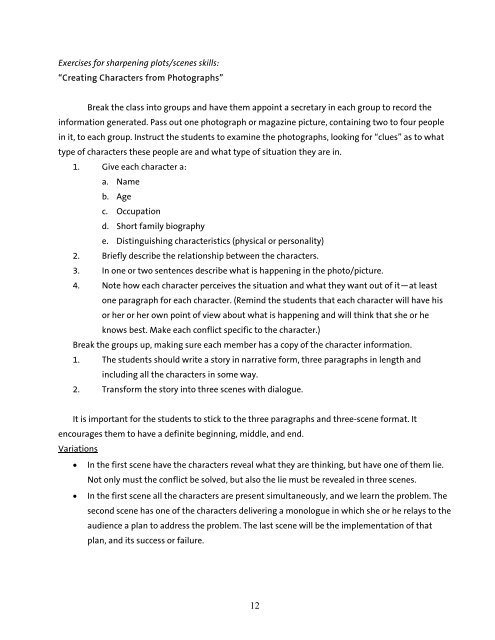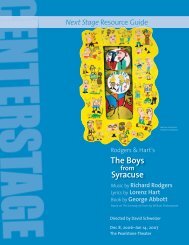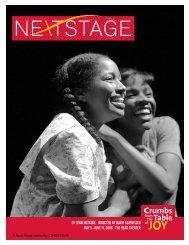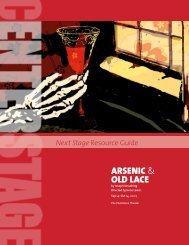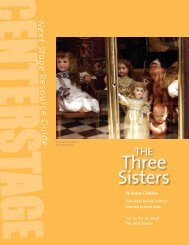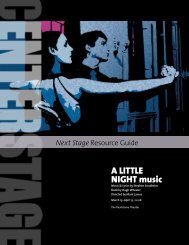Teaching Playwriting in Schools - Center Stage
Teaching Playwriting in Schools - Center Stage
Teaching Playwriting in Schools - Center Stage
You also want an ePaper? Increase the reach of your titles
YUMPU automatically turns print PDFs into web optimized ePapers that Google loves.
Exercises for sharpen<strong>in</strong>g plots/scenes skills:<br />
“Creat<strong>in</strong>g Characters from Photographs”<br />
Break the class <strong>in</strong>to groups and have them appo<strong>in</strong>t a secretary <strong>in</strong> each group to record the<br />
<strong>in</strong>formation generated. Pass out one photograph or magaz<strong>in</strong>e picture, conta<strong>in</strong><strong>in</strong>g two to four people<br />
<strong>in</strong> it, to each group. Instruct the students to exam<strong>in</strong>e the photographs, look<strong>in</strong>g for “clues” as to what<br />
type of characters these people are and what type of situation they are <strong>in</strong>.<br />
1. Give each character a:<br />
a. Name<br />
b. Age<br />
c. Occupation<br />
d. Short family biography<br />
e. Dist<strong>in</strong>guish<strong>in</strong>g characteristics (physical or personality)<br />
2. Briefly describe the relationship between the characters.<br />
3. In one or two sentences describe what is happen<strong>in</strong>g <strong>in</strong> the photo/picture.<br />
4. Note how each character perceives the situation and what they want out of it—at least<br />
one paragraph for each character. (Rem<strong>in</strong>d the students that each character will have his<br />
or her or her own po<strong>in</strong>t of view about what is happen<strong>in</strong>g and will th<strong>in</strong>k that she or he<br />
knows best. Make each conflict specific to the character.)<br />
Break the groups up, mak<strong>in</strong>g sure each member has a copy of the character <strong>in</strong>formation.<br />
1. The students should write a story <strong>in</strong> narrative form, three paragraphs <strong>in</strong> length and<br />
<strong>in</strong>clud<strong>in</strong>g all the characters <strong>in</strong> some way.<br />
2. Transform the story <strong>in</strong>to three scenes with dialogue.<br />
It is important for the students to stick to the three paragraphs and three-scene format. It<br />
encourages them to have a def<strong>in</strong>ite beg<strong>in</strong>n<strong>in</strong>g, middle, and end.<br />
Variations<br />
• In the first scene have the characters reveal what they are th<strong>in</strong>k<strong>in</strong>g, but have one of them lie.<br />
Not only must the conflict be solved, but also the lie must be revealed <strong>in</strong> three scenes.<br />
• In the first scene all the characters are present simultaneously, and we learn the problem. The<br />
second scene has one of the characters deliver<strong>in</strong>g a monologue <strong>in</strong> which she or he relays to the<br />
audience a plan to address the problem. The last scene will be the implementation of that<br />
plan, and its success or failure.<br />
12


